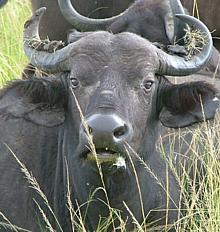
SAFARI
Users
- General & History
- Cuts of Beef
- Aging Beef
- Veal
- Who Eats Beef - and why others don't.
- Recipes
- Links
General & History
The generally category "Beef" includes Cattle, Yaks, Water Buffalo and Bison.
All domestic cattle descend from the wild Aurochs (Bos primigenius taurus) with domestication begining somewhere between 10,000 years ago and 8,000 years ago. By then sheep, goats, pigs and dogs had already been domesticated and were being sheared, milked, eaten and used to carry or pull loads.
In Thailand and the rest of Southeast Asia "beef" means water buffalo and there's little attention paid to particular cuts - you just buy a hunk of buffalo of the weight you want. It's all going to be cut into small thin pieces anyway because it's all a bit tough and you need to strech it because it's expensive.
In Europe and the U.S. where beef means cow, it's cooked in medium to large pieces as a feature dish and in various ways so cut is extremely important. Prime grilling cuts are so expensive the beef industry has recently invented new cuts that can be substituted for the astronomically priced ones.
Aging Beef
Beef is not considered at its best fresh from the animal, it's just too tough. This is why beef is not popular in many areas that lack refrigeration and why it's boiled in other such areas. With time the muscle fibers are digested by enzymes making it more tender. The problem here is giving the enzymes time to work without the beef rotting. Two aging methods are generally used:
Dry Aging
is done by hanging the carcass, quarter or primal cut in a room with carefully regulated temperature and air flow, generally for 7 to 20 days. Air flow is necessary to avoid spoilage but can't be too fast or the beef will become too dry. This aging process is relatively expensive but provides the most "beefy" flavored beef.Wet Aging
is done for nearly all your supermarket beef. Cuts are vacuum packed in plastic and the aging takes place during normal distribution, transportation and warehousing. At the destination store the package is opened and the final cuting and consumer packaging is done. Obviously this is a lot less expensive than the dry aging method.
Veal
Veal is the meat of a calf, an immature cow. It is pale in color and relatively tender compared to beef, with a flavor sort of between pork and beef. It is an inevitable byproduct of the dairy industry.
Veal production has been made highly controversial by animal rights advocates using highly emotional campaigns, often misleading or short on facts. The veal industry has countered with information campaigns which may also be misleading. For more on this subject see our page titled Veal - Controversy.
Who Eats Beef?
Cattle were domestigated well before the dawn of history, probably separately in Africa and Central Asia. Large areas of fertile grassland are necessary for raising cattle so it is not popular in heavily forested or dry parts of the world.
India
The sacred Vedas have specific instructions for beef, so obviously it was a common comestable in early India. It fell out of favor with the rise of Buddhism and the Krishna cult. Now major parts of India are vegetarian and the parts that aren't still don't eat cow (or don't admit it anyway). In any case, it is economically more advantageous to allow cattle to convert indigestible plant material into dairy products than to kill them for meat.The wide use of milk, cream and cheese in India does present a troubling ethical delema, especially for Jains and other extreme vegtarians. As a byproduct of dairy production, India is necessarily a major exporter of veal. They do it quietly, but everyone knows it's being done, and that there's no escape from it.
Asia, East, Southeast
Beef is eaten but in relatively small quantity compared to pig, except in Mongolia and Korea where beef is favored.Islam
Beef is not forbidden but is not much eaten in Islamic regions due to the strong Arabic influence in religion and custom. It was not economical or even possible to raise cattle in Arabia, most of the Middle East, or post-Roman North Africa - so lamb or mutton are much more common.Jews
Beef is approved by religious law. For Orthodox Jews it must be ritually saughtered and processed in accordance with the law.Christians
A powerful sub-cult of the Pagans (a Cult of the Dying God), Christians eat whatever they please and beef is a big item wherever it can be raised economically.
Links
- C01 - Breeds of Livestock - Oklahoma State University.



